Publisher: Amy Marson Creative Director: Gailen Runge Art Director: Kristy Zacharias Editors: Lynn Koolish and Katie Van Amburg Technical Editors: Alison M. Schmidt and Helen Frost Cover/Book Designer: April Mostek Production Coordinator: Jenny Davis Production Editor: Joanna Burgarino Illustrator: Wendy Mathson Photo Assistant: Mary Peyton Peppo Photography by Diane Pedersen, unless otherwise noted Published by Stash Books, an imprint of C&T Publishing, Inc., P.O. Box 1456, Lafayette, CA 94549 Dedication From Janice To JD for making this book possible. To Liam and Emmeline for being my biggest (and tiniest) fans. To my parents for always supporting my crazy, artistic endeavors. From Beth To M for inspiring me to start sewing and continuing to inspire me with your innovation and resourcefulness.
To E for being my constant companion at the sewing machine and for challenging and encouraging me to try new things. To T for keeping me laughing (as only a two-year-old can). To N and A for their support. To P for being there so this all could happen. Acknowledgments We would like to extend our gratitude to everyone who made this book possible, including all of the wonderful pattern contributors, our editors, C&T, and of course, our loving families. Thank you!  Neither of us could have imagined when we first met in 2012 that we would soon be collaborating on a book about quilting.
Neither of us could have imagined when we first met in 2012 that we would soon be collaborating on a book about quilting.
We met the same way that many modern quilters meet these daysthrough our quilting blogs. We were soon communicating daily, not only about quilting but also about life in general. During the summer of 2013, we were each individually working on ideas for a quilting book. We chatted about it often, and then one day we thought: Wouldnt it be fun to write a book together? This conversation took place at the same time that the quilting world was introduced to Marcelle Medallion by Alexia Marcelle Abegg, from her book Liberty Love.  Marcelle Medallion by Alexia Marcelle Abegg BETH Janice had been working on designs for a medallion quilt and suggested that as the topic for our book. I was hesitant, thoughdont medallion quilts require perfect precision, planning, and accuracy? That was not exactly my style of quiltmaking.
Marcelle Medallion by Alexia Marcelle Abegg BETH Janice had been working on designs for a medallion quilt and suggested that as the topic for our book. I was hesitant, thoughdont medallion quilts require perfect precision, planning, and accuracy? That was not exactly my style of quiltmaking.
We talked about other ideas, but Janice kept bringing back the idea of a book about modern medallions. I was thinking that maybe we should go back to each writing our own book proposals, but then late one night, a design idea came to me. It was one of those times when you have to get out of bed and write it down so you dont forget. It was a lightbulb moment for me when I realized that the definition of a medallion quilt is just a quilt made up of borders surrounding a center medallionnowhere in that definition does it state that they have to be equal, perfect, or matched. I drew my design and emailed it to Janice, along with a note saying, Yes, lets write a book about modern medallions. JANICE From the moment Beth and I first discussed it, I was seriously excited and invested in the idea of a medallion book.
I love a challenge, and I get a thrill out of teaching people new techniques that expand their sewing universe. A medallion is the perfect canvas for quiltmakers to learn new skills and become comfortable deviating from a written project to find their own style. Its a sort of sampler quilt in the round. I was very happy when Beth finally came round and agreed to the book concept. Although we are both modern quilters, our design tastes and our sewing styles are very different, which helps us write for a variety of quilters. We spent the next several days thinking more and more about the idea and getting more excited with each email we sent.
Through these conversations, we realized that we wanted the book to include a unique, varied selection of medallion quilts from a diverse group of quilt designers and that we wanted the book to be more than just projects. We wanted it to be a resource for all quilters wanting to design their own modern medallion quilts. As such, it would include information for resizing and modifying borders to create unique quilts by mixing and matching the elements from the books projects. We also wanted to include detailed instructions and information for piecing the more popular designs used in medallion quilts. Several emails later, the idea for The Modern Medallion Workbook was borna book that includes eleven complete projects in a variety of styles and the tools and inspiration to help you, the reader, build your own modern medallion quilt. Introduction A medallion quilt is simply defined as a quilt composed of a center motif surrounded by multiple borders.
This style of quilting was brought to America in the late 1700s by the colonists emigrating from Europe. These medallion quilts (referred to as framed quilts in Europe) included both symmetrical and asymmetrical styles and were made using many techniques, from simple patchwork to intricate piecing and appliqu. The center motifs in these early medallions were often made from either appliqu, wholecloth printed fabrics, or a pieced design. The borders were also pieced, appliqud, or a combination of both. Some quilts had many borders, while others had just a few, allowing the center to remain the star. Medallions remained a popular style of quilting until the 1840s, when many quiltmakers began using rows of blocks instead.
In recent times, however, the medallion quilt has had a resurgence in the modern quilting movement. Although the definition of a medallion quilt remains the same, through the addition of modern fabrics and a modern aesthetic, this quilt has become increasingly popular with modern quilters. While there are many definitions of what makes a quilt modern, we believe it is a subjective test and that you decide whether a quilt is modern or traditionalor whether that distinction even matters. Making a modern medallion quilt is a process, and we want you to enjoy every single step, just as we do. We encourage you to slow down, take your time, and embrace the creativity that goes into making a medallion quilt. Begin by mindfully choosing your fabrics and planning your design; weve even included line drawings that you can use as coloring pages to help with this (see ).
Dont rush this first step! Continue to enjoy the process with each new bordertry a technique youve never tried before (remember, the seam ripper is your friend); challenge yourself. Your efforts will be rewarded when you see your modern medallion masterpiece!  FABRIC CONSIDERATIONS One of our favorite parts of starting a new project is selecting the fabrics. And making a modern medallion quilt provides lots of opportunity for fabric play. You can decide the fabrics for your entire quilt all at once, or you can plan the quilt border by border. If you are going to select fabrics along the way, decide on an overall theme or color scheme at the beginning to keep the borders harmonious. One way to figure out a color palette is by selecting one piece of print fabric to inspire the rest of the selection.
FABRIC CONSIDERATIONS One of our favorite parts of starting a new project is selecting the fabrics. And making a modern medallion quilt provides lots of opportunity for fabric play. You can decide the fabrics for your entire quilt all at once, or you can plan the quilt border by border. If you are going to select fabrics along the way, decide on an overall theme or color scheme at the beginning to keep the borders harmonious. One way to figure out a color palette is by selecting one piece of print fabric to inspire the rest of the selection.
You dont have to be bound to the colors in that fabric or even use that fabric; instead you can use it as a guide to choose other fabrics that complement each other. Another option is to build the color palette by taking inspiration from a favorite photo, a piece of art, or any other object that is special to you. If you decide on a scrappy look for your quilt, consider choosing fabrics with only a few colors in each print, as this will result in a less busy design when the fabrics are combined. When choosing fabrics, consider the size of the pieces you are cuttingif you choose a design with mostly small pieces, you might want to focus on small- and medium-scale print fabrics, since any large print will get lost when you chop it into small pieces.
Next page

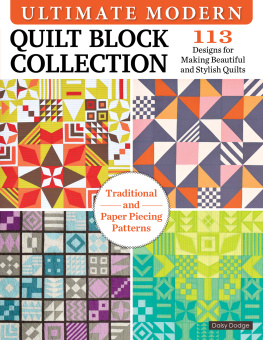

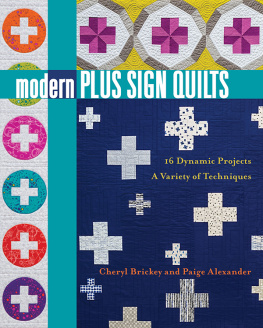
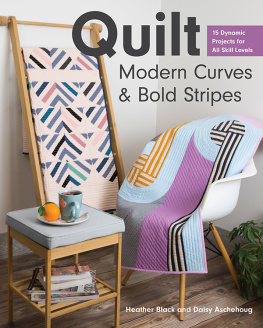
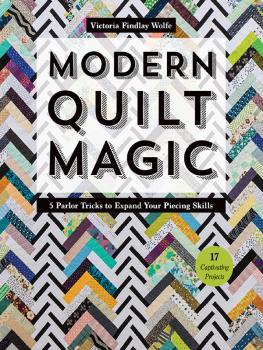
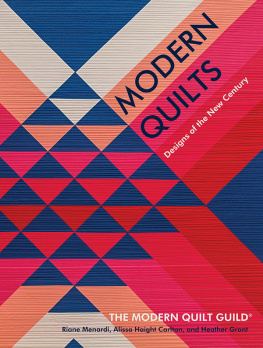
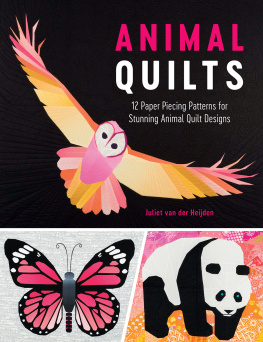

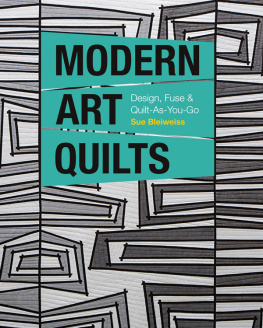
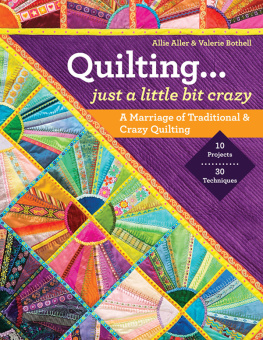
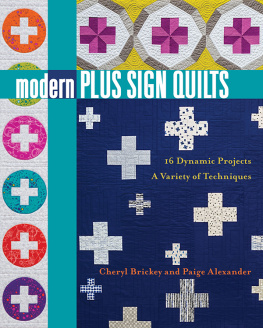
 Neither of us could have imagined when we first met in 2012 that we would soon be collaborating on a book about quilting.
Neither of us could have imagined when we first met in 2012 that we would soon be collaborating on a book about quilting. Marcelle Medallion by Alexia Marcelle Abegg BETH Janice had been working on designs for a medallion quilt and suggested that as the topic for our book. I was hesitant, thoughdont medallion quilts require perfect precision, planning, and accuracy? That was not exactly my style of quiltmaking.
Marcelle Medallion by Alexia Marcelle Abegg BETH Janice had been working on designs for a medallion quilt and suggested that as the topic for our book. I was hesitant, thoughdont medallion quilts require perfect precision, planning, and accuracy? That was not exactly my style of quiltmaking. FABRIC CONSIDERATIONS One of our favorite parts of starting a new project is selecting the fabrics. And making a modern medallion quilt provides lots of opportunity for fabric play. You can decide the fabrics for your entire quilt all at once, or you can plan the quilt border by border. If you are going to select fabrics along the way, decide on an overall theme or color scheme at the beginning to keep the borders harmonious. One way to figure out a color palette is by selecting one piece of print fabric to inspire the rest of the selection.
FABRIC CONSIDERATIONS One of our favorite parts of starting a new project is selecting the fabrics. And making a modern medallion quilt provides lots of opportunity for fabric play. You can decide the fabrics for your entire quilt all at once, or you can plan the quilt border by border. If you are going to select fabrics along the way, decide on an overall theme or color scheme at the beginning to keep the borders harmonious. One way to figure out a color palette is by selecting one piece of print fabric to inspire the rest of the selection.